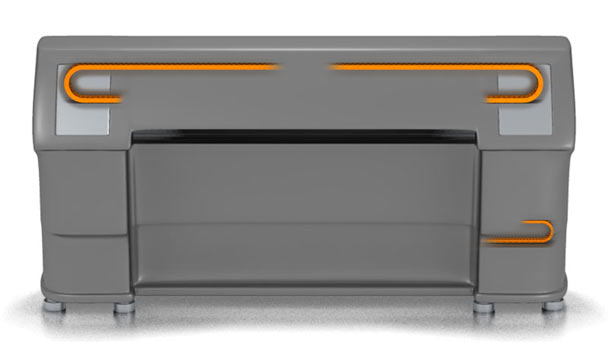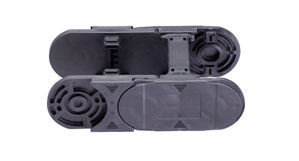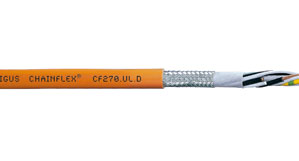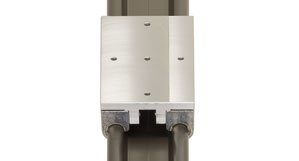Around the world, there are large posters, colorful truck canvasses and a host of other information conveying media. A large format digital printer is needed to print appealing images on these media. By now it is possible to print on media with a width of seven meters using the ink-jet process.
Nearly 500 years ago, Johannes Gutenberg became the father of printing with the book printing press. Today's digital printers are based on the same principle. DIN 16 500 states that information is replicated by applying printing ink to a medium, which occurs by employing a printed image matrix.
Today, the large format printer is one of the most important tools that the advertising industry can no longer do without. For instance, it creates volume printing options for posters, which are essential to many campaigns.
The operating principle of an inkjet printer is easily explained. There are three different technologies: The continuous inkjet principle, the drop on demand process and UV direct print. The continuous inkjet principle electro-statically charges the ink in the printhead, which is then deflected by current differences on an electrode. Not required ink droplets are reclaimed. The second process, drop on demand, only creates the drops on the jet that are actually needed. This method has two sub-categories, the bubble-jet and the piezo principle. Bubble jet printers create tiny ink droplets using a heating element, which heats up the water in the ink. This results in an explosive expansion of a tiny vapor bubble, which presses an ink drop from the jet using the generated pressure. Piezo printers are based on the piezo principle. Ceramic elements deform when subjected to electrical current and press ink through a fine jet. This creates ink droplets whose volume can be controlled using an electrical impulse. The last process is UV printing, which is distinctly different from the other operating principles. Unlike the other principles, this method is not based on water or solvents. The ink does not penetrate the printed substrate material, but is instead deposited and hardened using UV light. This process can be used to print on nearly any surface, for instance glass or ceramics. Another area of differentiation is the method of feeding the printed material. Differences are made between roller print systems and flatbed printers. The roller print system feeds the material by means of rollers; the flat bed printer secures the printed medium on a large surface, which moves during the printing process in place of the printer unit.
Large format printers

Since industry has an increasing demand for the use of large format printers or plotters, it is particularly important that these work reliably. The mechanical movement must operate smoothly, in order to avoid extensive downtime.
Large format printers or plotters must be able to create a large, high-quality printed image within a minimum of time. To make this happen, the printer must have high-speed dynamics and stand up to high loads. The low-maintenance energy supply system operates with vibration and wear-resistant igus® energy chains, such as the series E3 or E6, permitting a smooth, quiet and therefore very smooth operating method for large format printers. In order to meet the demanding requirements, the direct printing operation (X-axis, connection to the printheads) is dependent on a wear-resistant energy chain that is designed for highly dynamic applications: The E3 systems, which are ideally suited for ribbon cables due to the small bending radius of the energy supply and the flat but wide filling space, or the larger, rugged and small linked E6. A more cost effective version is the drag chain E2/000, whose simplified design was developed for less demanding applications.
Of course the cable must play along. For this purpose, igus® also developed a wear-resistant product range of highly flexible chainflex® cables, which were specially developed for use in plastic energy chains. Ideal for small radii and highly dynamic motions. Among others, the energy supply systems are suitable for digital, poster and canvass printers.
But linear guides are also used in large format printers. Here as well, igus® can provide a broad product range: igus® drylin® linear guide systems. igus® linear technology has one key advantage, because all igus® plain and linear guides are dry-running and maintenance-free, which means they are not lubricated and therefore also do not contaminate the printed product with oil fog or even oil drops. In addition, the maintenance-free linear units operate jerk-free and have nearly no wear, therefore generating no abrasion particles. drylin® was also classified by IPA.
Products for use in large format printers
Energy supply chains
Protection of cables and hoses
Easy assembly through faster opening and separating of links
Low wear through special optimized igus® polymers
Stable, cable-friendly rounded cross bars
Interior separation tool box for high lifetime
High product diversity for virtually every application and special materials for particular application areas possible
Available from stock with many accessories
Cables
Over 950 cable types from stock
No minimum order
No cutting costs
Special design for move in e-chains®
Various jacket materials
Linear guide systems
Small cross section
Lubricant free
Replaceable plastic gliders
Lightweight
Already implemented customer applications
”Virtu“ large-format printer
The ”Virtu“ large-format printer can be used to print almost anything: sheetmetal, foils, textiles, wood, glass, and, of course, also paper in widths up3.5 metres.
Printing machine industry
For increased service life - Low-cost angular sensor with special bearings in printing machines.
Lifter system for printing machine
Arguments for noise minimization and reduction of maintenance rate were decisive here.
Printer and plotter
Printer and plotter - low drive forces, low sliding friction coefficients.
More than 100,000 products available! Delivery and consultation Mon-Fri from 7am-8pm and Sat from 8am-12pm!

 E3 system - overview
E3 system - overview








